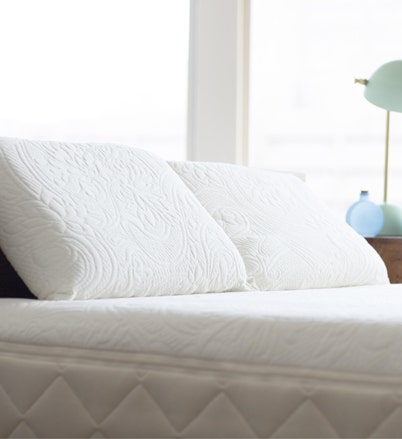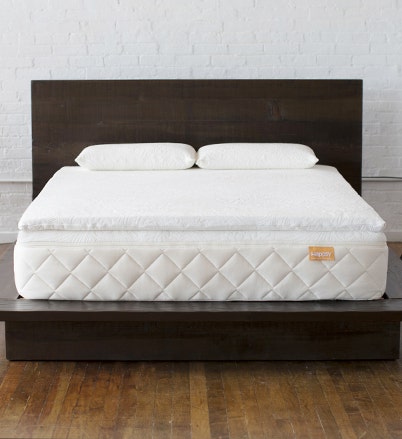
Chances are you’ve seen trending ASMR videos pop up on your TikTok or Instagram Reels. In fact, a lot of people had never even heard of ASMR before it trended on social media.
To the unfamiliar social media scroller, ASMR can seem uncomfortable and even a bit silly. But there’s a reason behind its appeal and why this sensory phenomenon is sweeping social media.
ASMR videos and techniques could have the power to transform your sleep for a more peaceful and restorative slumber. And in today’s fast-paced world full of stress and anxiety, that’s something everyone could benefit from.
Let’s take a closer look at ASMR for sleep.
What is ASMR?


Have you ever felt a shiver down your spine … but in a good way? Or used one of those scalp massagers shaped like a claw?
If you answered yes, that’s sort of how Autonomous Sensory Meridian Response (ASMR) is supposed to feel. That is, if it works on you. It’s been noted that only 10-20% of the global population can experience ASMR.
The ASMR phenomenon is characterized by a tingling sensation that typically begins on the scalp and moves down the back of the neck and upper spine in response to certain auditory or visual stimuli. These stimuli, often referred to as "triggers," can include things like:
- Whispering
- Tapping
- Crinkling sounds
- Gentle brushing
- Page turning
- Tapping nails
ASMR enthusiasts describe the experience as deeply relaxing and pleasurable, sometimes inducing a state of euphoria or calmness. While the scientific understanding of ASMR is still evolving, many individuals turn to ASMR videos and content online as a means of relaxation, stress relief or – you guessed it – a sleep aid.
ASMR and your brain
This is your brain on ASMR. While research is still in its preliminary stages, studies suggest that ASMR triggers may activate brain regions associated with emotional regulation and reward processing, such as the insula, prefrontal cortex and limbic system.
Neuroimaging studies have shown increased activity in these areas when individuals experience ASMR, indicating a potential link between ASMR and the brain's reward system. These activated regions of the brain are involved with the release of neurotransmitters, like dopamine, serotonin, and oxytocin.
Over time, regular exposure to ASMR stimuli may potentially contribute to improved sleep quality, reduced anxiety and enhanced overall mental health. (Yeah, we’ll take a big dose of that, please!)
Benefits of ASMR
While scientific research on ASMR is still in its early stages, benefits reported by individuals who experience them include:
- Relaxation
- Improved sleep
- Stress reduction
- Increased focus
- Feelings of wellness
- Pain relief
- Creativity enhancement
Because sleep is something that we’re passionate about at Happsy, we also wanted to note that beyond improved sleep being a benefit of ASMR in and of itself, many of the other benefits of ASMR – like stress reduction, relaxation, pain relief and feelings of wellness – are known to improve sleep quality, too. So, if you’re in the one-fifth of the population that can experience ASMR and you’re wondering if ASMR for sleep really helps, the answer is yes … and yes!


Are there any downsides to ASMR?
Perhaps the most significant downside is that not everyone can experience ASMR for sleeping, and, for those who don't, the content may seem strange or even uncomfortable.
Some individuals may find certain ASMR triggers unpleasant or triggering, such as mouth sounds or whispering, which can induce anxiety rather than relaxation. This is known as misophonia, which is a sound sensitivity syndrome.
Lastly, excessive consumption of ASMR content, like any other form of media, can potentially lead to dependency, where individuals rely heavily on ASMR videos for sleep and relaxation, potentially hindering their ability to cope with stress – or fall asleep – without it.
How ASMR supports sleep
ASMR is popularly associated with sleep. Bedtime is the most common time for people to use ASMR, and a reported 81% of ASMR users do so before going to bed.
Many individuals find ASMR triggers such as gentle whispers, tapping sounds or soft brushing to be soothing and conducive to falling asleep. The repetitive and rhythmic nature of ASMR content can help quiet the mind, alleviate stress and promote a sense of tranquility, making it easier for people to drift off into a restful sleep. ASMR videos often encourage deep breathing and mindfulness, further aiding in relaxation, improving sleep quality and combating insomnia.
Although research is still developing, it’s been implied that ASMR puts some individuals into a sort of “flow state” of focused attention which can be beneficial in transitioning from a hectic day to a more grounded state before bed.
Common ASMR triggers for sleep
Common ASMR for sleep triggers include a variety of gentle, soothing stimuli that induce a state of relaxation and calmness. The majority of ASMR triggers are auditory, but they can also be visual or tactile. Here are a few.


Whispering
Whispering as an ASMR trigger utilizes soft, gentle voices to create a calming atmosphere. This method often involves close-up whispers, sometimes binaural, where the sound moves from one ear to the other, simulating a personal, intimate experience.
Comforting affirmations, bedtime stories or simply soothing phrases are whispered to evoke a sense of security and tranquility. The quiet, intimate nature of whispering can help reduce stress and anxiety, easing the listener into a peaceful state conducive to sleep.
Crisp sounds
Crisp sounds refer to the clear, precise, and often delicate noises such as crinkling, tapping, scratching or brushing on various surfaces. These sounds are valued for their ability to produce a meditative-like state, where the repetitive and predictable nature of the sounds focuses the listener's attention, reducing racing thoughts and inducing a deeply relaxed state.
The rhythmic pattern of these sounds can mimic the soothing effects of a lullaby, helping to lull listeners into a restful sleep.
Rainfall
The natural sounds of rainfall, waves crashing or gentle winds are powerful ASMR triggers that mimic the soothing ambience of nature. These sounds can transport the listener to a serene environment, away from the hustle and bustle of daily life.
The rhythmic pattering of rain or the consistent crashing of waves creates a white noise effect, masking distracting sounds and providing a tranquil backdrop for sleep. This connection to nature's simplicity and the repetitive, gentle sounds promote relaxation and can significantly improve sleep quality.
Visual triggers
Visual ASMR triggers involve slow, methodical, and often repetitive visual stimuli that can induce relaxation. Watching deliberate movements, such as someone brushing their hair, folding towels or performing gentle hand motions, can mesmerize the viewer, leading to a meditative state.
The visual focus required to follow these actions can distract from stressors and lead to a calming effect, making it easier to drift off to sleep. The simplicity and predictability of these actions provide a soothing visual experience that complements auditory triggers.


And more!
Other triggers might include:
- Soft speaking
- Typing
- Fans blowing
- Turning the pages of a book
- Slow hand motions
- Haircuts
- Massages
- Towel folding
The key is to remember that ASMR doesn’t describe the stimulus – it describes the reaction, which is typically described as a tingling or warm feeling. In a way, anything can be an ASMR trigger!
How to add ASMR to your bedtime routine
Incorporating ASMR for sleeping into your nightly ritual will look different for everyone. Here is some direction if you’re still unsure of where this fits into your nighttime routine:


Find what triggers work for you
Incorporating ASMR into your bedtime routine should begin by selecting ASMR triggers that resonate with you. Whether you need to download an app or put on headphones, make sure to gather everything you need for ASMR.
Experiment with different ASMR videos or audio tracks until you find ones that induce a sense of calm and tranquility.
Block blue light
Because devices with screens emit harmful blue light that can actually interfere negatively with sleep quality, it’s important to block yourself from blue light exposure. This can be done by wearing blue light blocking glasses or opting for touch- or sound-based ASMR triggers to avoid screens.
There is plenty of audio-only ASMR content that may be more suitable for bedtime.
Create a routine
First, watch your ASMR videos while you are in bed, right before going to sleep and before turning off the lights. (Wear your blue light blocking glasses!) Do this for an hour or so to get into a more relaxed mode – while avoiding too much screen time before bed.
Once you’re in bed with the lights off, switch to audio-only ASMR to minimize distractions and get to sleep.
Whether you find relaxation in the whisper of a gentle voice, the delicate tapping of fingertips or the rhythmic sound of rainfall, if ASMR works for you, then there's an ASMR trigger out there waiting to guide you into a deep and peaceful slumber.
And if ASMR doesn’t work for you, well, that’s what we’re here for. Never underestimate the power of a high-quality organic mattress on your sleep quality. (Plus, we’ve got lots of other helpful sleep tips over on our blog like sleep sounds, yoga nidra and more!)





